3.0 Soil Health
Understanding Soil
Soil is more than just dirt; it is a fascinating part of your farm that more organisms live in than another other part by far. A single teaspoon of rich soil can hold up to one billion bacteria, several yards of fungal filaments, several thousand protozoa, and lots of nematodes (see the Soil Food Web image below). Improving the health of your soil will ensure that plants and animals are growing well on your farm, and taking care of the soil will be worth your time and investment.
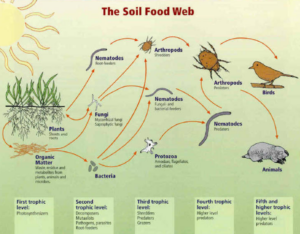
Soil health is made up of its physical structure, soil chemistry, and biology, outlined below in more detail. The basic components of soil are gravel, sand, silt, clay, organisms, air, water and organic matter.
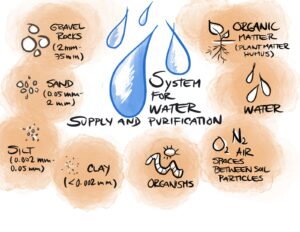
Components of Soil Health:
- Soil Structure (Sand, silt, and clay)
- Soil Chemistry (Nutrients, minerals, and pH)
- Soil Biology (Insects, fungus, and bacteria)
- Organic Matter
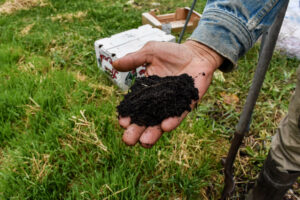
Soil Structure (Sand, Silt, and Clay)
Soil is made of three basic parts: sand, silt, and clay which are different sized particles. To figure out the percentage of each in your soil, collect about 1 cup of soil (try to avoid gravel or sticks) and add it to a large mason jar with water. Shake the jar, and let it sit for at least 24 hours. You can see the height of each layer in the jar; leaves and debris will float to the stop, the sand will be at bottom as it is most dense (with the largest particle size of 0.05mm-2mm), then silt with medium density (and particles sized 0.002mm-0.05mm), and clay will be the top layer as it is least dense with the smaller particle size (<0.002mm).
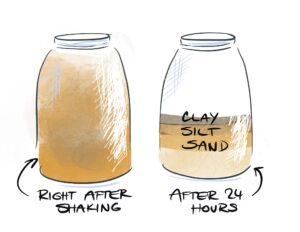
Soil Chemistry
The three main nutrients in your soil that are important for plant growth are nitrogen (N), potassium (P), and phosphorus (K):
- Nitrogen (N) – Nitrogen is important for the growth of leaves on the plant
- Phosphorus (P) – Phosphorus is important for root growth, and the development of the flowers and fruits
- Potassium (K) – Potassium is a nutrient that helps the overall functions of the plant work well
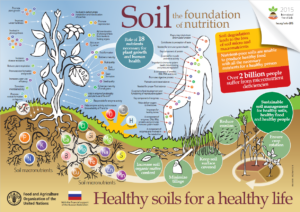
pH is another important factor for growth, as some plants prefer particular acidic or alkaline conditions. The ideal pH for most crops is between 6 and 7, as you can see in the diagram below, so if your soil is an average of 6.5, that would be favorable for most crops. If your pH needs to be increased, you can add limestone to your soil which releases slowly over time. Make sure you are doing soil tests after each application to achieve your target pH.
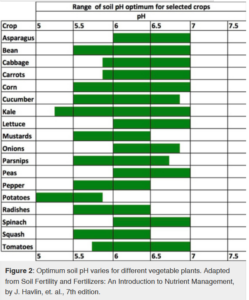
Soil Biology
The soil biology involves all of the organisms that live in the soil from bacteria to earthworms. Where your field is in succession (see the drawing below of a meadow transitioning to a forest) will tell you what kind of organisms live in it (bacteria vs fungus). Earthworms and beetles are easy to see, but the smaller bacteria and fungus plays a huge role in how well produce will grow in a field.
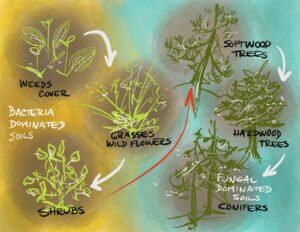
When you are assessing the site, consider where it is in its succession, a early succession grassland is bacteria-dominated, while the final succession phase of a forest is fungal-dominated (which the trees need for their mycorrhizal networks), more information here. When you plan your crops, consider what is there already and if you want to change what is growing there, you will have to add either bacteria or fungus to the soil. For example, planting a fruit tree in a lawn will not grow well if you don’t add some soil from a forested area to the base of it. If you plant annual crops in a forest, they also will not grow well.
- Fungal-dominated crops include nut trees, fruit trees, fibre plants, and shrubs
- Bacteria-dominated crops include annual fruits and vegetables
Organic Matter
Organic matter is all of the carbon-based compounds that are present in your soil, which comes from plant debris, decomposed root systems, and is the top layer of your soil. The depth of the organic matter will vary from property to property, depending on what has been growing there recently, and how much soil was created over the previous millennia!
The percentage of organic matter in your soil will appear in soil test results. Soil stores an incredible amount of carbon, so keeping soils healthy is an important part of climate change mitigation as shown in the diagram below.
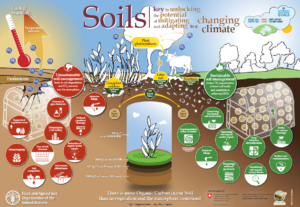
To maintain and build organic matter, adhere to these soil health principles:
- Keep soil covered (no bare soil, aka “soil amour“) – discourages weeds and builds soil
- Disturb soil as little as possible
- Keep plants growing throughout the year
- Encourage plant diversity (crop rotation, cover crops, etc.)
- Integrate animals (or animal manure and tools to mimic them)
Organic matter can be built up in a number of ways, including making and adding compost (or compost teas or foliar sprays) with plant debris and food scraps from your farm and/or surrounding properties, adding peat moss, mulching crops, and feeding your soil organisms to continue building soil.
When measuring the quality of your organic matter (or any soil additions), consider the carbon (C) to nitrogen (N) ratio. This ratio is very important in building compost and adding anything to soil. If there is too much carbon (dried leaves, sticks, sawdust, wood chips) in the soil, the microbes will use the available nitrogen to break it down, leaving less available to the plants. Ideally, you want to add materials that have fairly equal amounts of C and N. For more information, read C:N in Cropping Systems.

Soil Assessment
Once you have your farm plan, think about your soils and where you will be farming on the property. Figure out your soil baseline so you know where you are starting from using the BC Soil Information Finder Tool (BCSIFT) tool; a step-by-step explanation is below.
Activity: Figure out your soil baseline
- Go to BCSIFT to learn about your property’s soil.
- Find your property by typing in the address or scrolling around the map to find it
- Once you have found your property, click on the Agricultural Capacity tab on the left.
- Left-click on your mouse the polygon that includes your property.
- CC Label: Soil class and subclass
- CC1 Class: Soil class
- CC1 Subclass 1 / CC1 Subclass 2: Soil subclass(es)
- Information on the soil classes: Soil class (number) and the subclass (letter) will give you a lot of information about the crops that will grow there, and the limitations you have on the soil.
- What is the soil series?
- What is my soil texture?
- Determine the baseline (what it is right now).
After determining your soil baseline, find a company who will do a soil test, and collect your samples for testing. This will give you information about what nutrients are present (make sure you get samples from all over the property), if there are any heavy metals in the soil, and a lot more information.
Once you have an understanding of your soil, it will be easier to figure out what you need to do to improve the soil. There are so many management practices to increase your soil quality, and it all depends on the baseline. For example, you might have to build up the nutrients in your soil before you can grow crops. Remember that many soils in BC are new and young (it takes 100,000s of years to build soil!), so the soil often needs to be built (poor soils may not have been mismanaged, there just is not very much there).
Some examples of soil management practices are growing cover crops, green manure, and relay cropping to help build your soil (more in 3.1 Land Management Practices). These practices mimic natural processes, but speed them way up!
Soil Goals
Now that you have established your baseline, think about your soil goals.
Activity: Make some goals for your soil
What are the goals for my soil?
- What do I want to be able to grow here? How will I build the soil so that I can grow what I want to?
- When do I want to be able to grow those plants?
- What are my resources (money, labour, manure, livestock, etc)?
- What are my equipment and tools on hand?
Further Reading
- Province of BC Agriculture and Soil Health
- BC Nutrient Management Calculator
- C:N Ratios in Cropping Systems
- This Steeped in Soil resource by 4H Canada explains soil health very clearly, and includes several soil tests and activities, including the Ribbon Test
- BCSIFT
- Soil Health principles
- The Market Gardener by Jean-Martin Fortier (p.53-79) – Lots of information about soil health and organic fertilization methods
- Regenerative Agriculture by (p.226-239) – Lots of information about compost
